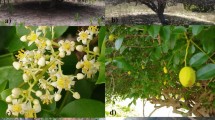Abstract
Meiotic and karyotypic analyses of six populations of two closely related species belonging to the section Eusideritis of the genus Sideritis (five of S. saetabensis and one of S. tragoriganum) (Lamiaceae), revealed polymorphisms for asymmetric reciprocal translocations. Two populations of S. saetabensis (S-046 and S-089) and the population of S. tragoriganum (S-056) contained heterozygotes and standard homozygotes. No homozygotes for the rearrangement (dicentric) were found. The meiotic behavior of the heterozygotes showed great stability of the dicentric chromosomes in both species due to strict control of meiosis at three levels: (1) chiasma formation, (2) multivalent coorientation at metaphase I, (3) dicentric chromatid separation at anaphase II. During mitosis there may also be strict control of dicentric chromatid separation through 100% parallel separation without interlocking. This stable polymorphism for asymmetric reciprocal translocations is a unique phenomenon that seems to be maintained by over-dominance, thus being a special case of linkage disequilibrium. We give two alternative hypotheses to explain the origin of these polymorphisms and discuss their evolutionary significance.
Similar content being viewed by others
References
Avise JC (1976) Genetic differentiation during speciation. In: FJ Ayala (ed) Molecular evolution. Mass: Sinauer Ass, Sunderland, pp 106–122
Bentzer B, Bothmer R, Engstrand L, Gustafsson M, Snogerup S (1971) Some sources of error in the determination of arm ratios of chromosomes. Bot Notiser 124:65–74
Coates DJ (1979) Karyotype analysis in Stylidium crossocephalum (Angiospermae: Stylidiaceae). Chromosoma 72:347–356
Daniel A, Lam-Po-Tang PRLC (1976) Structure and inheritance of some heterozygous Robertsonian translocations in man. J Med Genet 13:381–388
Darlington CD (1965) Cytology. Part I: Recent advances in cytology, 1937. Part II: Recent advances in cytology, 1937–1964. J and A Churchill Ltd, London
Essad S, Arnoux J, Maia N (1966) Contrôle de validité des caryogrammes. Aplication au caryotype de Lolium perenne L. Chromosoma 20:202–220
Fernández-Peralta AMa (1981) Estudios citogenéticos y evolutivos en el género Sideritis L. (Lamiaceae). Tesis Doctoral. División de Biología. Facultad de Ciencias. Universidad Autónoma. Madrid, Spain
González-Aguilera JJ, Fernández-Peralta, AMa (1981) Karyology and evolution in Sesamoides (Resedaceae). Plant Syst Evol 139:147–154
González-Aguilera JJ, Fernández-Peralta AMa, Sañudo A (1980a) Cytogenetic and evolutionary studies on the Spanish species of the family Resedaceae L: Sections Phyteuma L and Resedastrum Duby. Bol Soc Brot Sér 2, 23:519–536
González-Aguilera JJ, Fernández-Peralta AMa, Sañudo A (1980b) Estudios citogenéticos y evolutivos en especies españolas de la familia Resedaceae L: Sectión Glaucoreseda DC, Anales Jard Bot Madrid 36:311–320
Hair JB (1954) The origin of new chromosomes in Agropyron. Heredity 6:215–233
Hatch FT, Bodner AJ, Mazrimas JA, Moore II DH (1976) Satellite DNA and cytogenetic evolution: DNA quantity, satellite DNA and karyotypic variations in kangaroo rats (genus Dipodomys). Chromosoma 58:155–168
Holmquist G, Dancis B (1980) A general model of karyotype evolution. Genetica 52/53:151–163
Hsu TC, Pathak S, Chen TR (1975) The possibility of latent centromeres and a proposed nomenclature system for total chromosome and whole arm translocations. Cytogenet Cell Genet 15:41–49
John B, Lewis KR (1965) The meiotic system. Protoplasmatologia Band VI, F1. Springer, Wien, New York
Lewis H (1953) The mechanism of evolution in the genus Clarkia. Evolution 7:1–20
Lewis H (1962) Catastrophic selection as a factor in speciation. Evolution 16:257–271
Lewis H (1966) Speciation in flowering plants. Science 152:167–172
Mayr E (1976) Populations, species and evolution. Harvard University Press, Cambridge Mass, London
Morrison JW (1954) A dicentric wheat chromosome in division. Can J Bot 32:491–502
Nagl W (1978) Endopolyploidy and polyteny in differentiation and evolution. North-Holland Publ Comp, Amsterdam New York Oxford
Nakagome Y, Teramura F, Kataoka K, Hosono F (1976) Mental retardation, malformation syndrome and partial 7p monosomy (45,XX, t dic(7; 15)(p21; p11)). Clin Genet 9:621–624
Neibuhr E (1972a) Unusual findings by fluorescent microscopy of a t(13q, 14q). Humangenetik 15; 90–92
Neibuhr E (1972b) Dicentric and monocentric Robertsonian translocations in man. Humangenetik 16:217–226
Sañudo A (1971) Variabilidad cromosómica de las Genisteas de la Flora Española en relación con su ecología. Cuad Biol 1:5–21
Schmidtke J, Brennecke H, Schmid M, Neitzel H, Sperling K (1981) Evolution of Muntjac DNA. Chromosoma 84:187–193
Sears ER, Camara CA (1952) A transmissible dicentric chromosome. Genetics 37:125–135
Sokal RR, Rohlf FJ (1969) Biometry. WH Freeman and Company, San Francisco
Stebbins GL (1971) Chromosomal evolution in higher plants. Edward Arnold (Publishers) Ltd, London
Steinitz-Sears LM, Sears ER (1953) Chiasmata and crossing over in a dicentric chromosome in wheat. Genetics 38:244–250
Sybenga J (1959) Some sources of error in the determination of chromosome length. Chromosoma 10:355–364
Sybenga J (1975) Meiotic configurations. Springer, Berlin, Heidelberg, New York
White MJD (1969) Chromosomal rearrangements and speciation in animals. Ann Rev Genet 3:75–98
Author information
Authors and Affiliations
Rights and permissions
About this article
Cite this article
Fernández-Peralta, A.M., González-Aguilera, J.J. & Sañudo, A. Polymorphisms for asymmetric reciprocal translocations in two species of the genus Sideritis L. (Lamiaceae). Chromosoma 88, 83–89 (1983). https://doi.org/10.1007/BF00329506
Received:
Accepted:
Issue Date:
DOI: https://doi.org/10.1007/BF00329506




